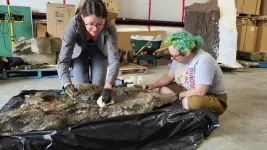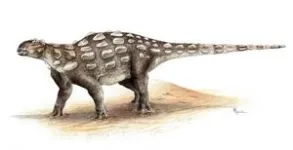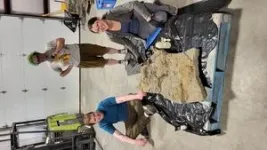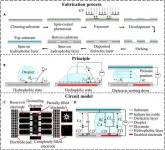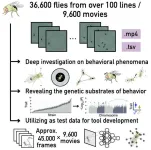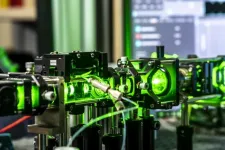(Press-News.org) Victoria, BC— For the first time, footprints of armoured dinosaurs with tail clubs have been identified, following discoveries made in the Canadian Rockies. The 100-million-year-old fossilized footprints were found at sites at both Tumbler Ridge, BC, and northwestern Alberta.
There are two main groups of ankylosaurs. Nodosaurid ankylosaurs have a flexible tail and four toes, while ankylosaurid ankylosaurs have a sledgehammer-like tail club, and only three toes on their feet.
Unlike the well-known ankylosaur footprints called Tetrapodosaurus borealis found across North America, which have four toes, these new tracks have only three—making them the first known examples of ankylosaurid ankylosaur footprints anywhere in the world. The expert team named the new species of this ankylosaurid ankylosaur Ruopodosaurus clava. It means 'the tumbled-down lizard with a club/mace,' referencing both the mountainous location in which these tracks were discovered and the distinctive tail clubs of these dinosaurs.
A research team including Dr. Victoria Arbour, the curator of palaeontology at the Royal BC Museum, alongside researchers from the Tumbler Ridge Museum and the Tumbler Ridge UNESCO Global Geopark, report their findings in the peer-reviewed Journal of Vertebrate Paleontology.
“While we don’t know exactly what the dinosaur that made Ruopodosaurus footprints looked like, we know that it would have been about 5-6 metres long, spiky and armoured, and with a stiff tail or a full tail club,” says Arbour, an evolutionary biologist and vertebrate palaeontologist who specializes in the study on ankylosaurs. “Ankylosaurs are my favourite group of dinosaurs to work on, so being able to identify new examples of these dinosaurs in British Columbia is really exciting for me.”
Dr. Charles Helm, scientific advisor at the Tumbler Ridge Museum, had noted the presence of several of these three-toed ankylosaur trackways around Tumbler Ridge for several years, and invited Arbour to work together to identify and interpret them during a visit in 2023. Eamon Drysdale, curator at the Tumbler Ridge Museum, Roy Rule, geoscientist at the Tumbler Ridge UNESCO Global Geopark, and the late Martin Lockley, formerly of the University of Colorado, contributed to the study.
The tracks date back to the middle of the Cretaceous period, about 100 to 94 million years ago. No bones from ankylosaurids have been found in North America from about 100 to 84 million years ago, leading to some speculation that ankylosaurids had disappeared from North America during this time. These footprints show that tail-clubbed ankylosaurs were alive and well in North America during this gap in the skeletal fossil record. The discovery also shows that the two main types of ankylosaurs—nodosaurids and ankylosaurids, including this new three-toed species—coexisted in the same region during this time.
“Ever since two young boys discovered an ankylosaur trackway close to Tumbler Ridge in the year 2000, ankylosaurs and Tumbler Ridge have been synonymous. It is really exciting to now know through this research that there are two types of ankylosaurs that called this region home, and that Ruopodosaurus has only been identified in this part of Canada,” says Helm.
“This study also highlights how important the Peace Region of northeastern BC is for understanding the evolution of dinosaurs in North America – there’s still lots more to be discovered,” says Arbour.
This find gives us a new piece of the puzzle about the ancient creatures that once roamed what is now Canada.
END
Footprints of tail-clubbed armored dinosaurs found for the first time
2025-04-14
ELSE PRESS RELEASES FROM THIS DATE:
Structural optimization of microfluidic chips for enhancing droplet manipulation and observation via electrodynamics simulation
2025-04-14
A research paper by scientists at Beijing Institute of Technology and City University of Hong Kong presented a versatile electrodynamics simulation model designed to analyze the driving forces of partially filled electrodes to optimize the structural parameters of Digital microfluidic chips.
The research paper, published on Mar. 06, 2025 in the journal Cyborg and Bionic Systems, utilizes finite element analysis to determine the voltage distribution within the Digital microfluidic chip and calculates the driving force acting on the droplets using the principles of virtual work.
Digital microfluidic chips (DMCs) have shown huge potential for biochemical analysis ...
Stress, depression factor into link between insomnia, heavy drinking
2025-04-14
COLUMBUS, Ohio – Insomnia and hazardous drinking are so closely intertwined that estimates suggest at least one-third, and as many as 91%, of people who have a hard time with sleep also misuse alcohol.
A new study suggests that perceived stress and depression factor into the relationship between the two conditions – perhaps not a surprise. But because the relationship between insomnia and heavy drinking goes in both directions, the influence of stress or depression depends on which condition came first, the analysis found.
“We were most interested in how insomnia leads to drinking, and we found that seems to occur primarily through ...
Unlocking the genetic basis of animal behavior using fruit flies
2025-04-14
Years of research in the field of genetics have offered interesting insights spanning the origins and development of heredity and traits, offering valuable information on its influence on every aspect of life, right from eye color to susceptibility to certain diseases. But how do our genes influence the way we act, react to threats, and interact with others? Despite the recent advances in genetics, understanding the genetic foundations of behavior remains one of biology’s most fascinating challenges. Scientists have long turned to simpler organisms to help answer these questions, with the humble fruit fly emerging as an ideal candidate. These tiny insects share ...
New AASM position statement highlights the clinical significance of sleepiness and its impact on health and safety
2025-04-14
DARIEN, IL — The American Academy of Sleep Medicine has released a new position statement emphasizing the clinical significance of sleepiness and its impact on performance, health, mood, safety, and quality of life.
The position states that sleepiness is a critical patient-reported outcome that is associated with an increased risk for adverse health effects and diminished quality of life. The statement urges health care professionals, policymakers, and researchers to prioritize the evaluation, management, and treatment of sleepiness ...
USC scientists find a gut-brain link that may affect behavior in children with autism
2025-04-14
A new USC study suggests that gut imbalances in children with autism may create an imbalance of metabolites in the digestive system — ultimately disrupting neurotransmitter production and influencing behavioral symptoms.
The research, published today in Nature Communications, adds to a growing body of science implicating the “gut-brain” axis in autism. The discovery raises the possibility of new treatment avenues. It’s an example of how research at USC, and other universities, drives ...
Pioneering research reveals Arctic matter pathways poised for major shifts amidst climate change
2025-04-14
A new study has shed unprecedented light on the highly variable and climate-sensitive routes that substances from Siberian rivers use to travel across the Arctic Ocean. The findings raise fresh concerns about the increasing spread of pollutants and the potential consequences for fragile polar ecosystems as climate change accelerates.
The international research, published today in Nature Communications and led by the University of Bristol, in the UK, provides the clearest ever picture of how the underlying transport system, known as the Transpolar Draft, operates. It also uncovers the various factors controlling this major Arctic surface current, ...
Scientists may have solved a puzzling space rock mystery
2025-04-14
An international team of researchers may have answered one of space science’s long-running questions – and it could change our understanding of how life began.
Carbon-rich asteroids are abundant in space yet make up less than 5 per cent of meteorites found on Earth.
An international team of scientists from Curtin University’s School of Earth and Planetary Sciences, the International Centre for Radio Astronomy (ICRAR), the Paris Observatory and more scoured the globe to find an answer.
Published today in Nature Astronomy, researchers analysed close to 8500 meteoroids and meteorite impacts, using data from ...
Sleep matters: Duration, timing, quality and more may affect cardiovascular disease risk
2025-04-14
Statement Highlights:
While the strongest evidence exists that getting sufficient sleep (duration of sleep) is important for overall health , other components of sleep health, such as consistent bedtime, uninterrupted sleep, daytime functioning and self-reported sleep satisfaction, also contribute to cardiometabolic health and related risk factors, including heart disease, stroke, high blood pressure, high cholesterol, inflammation, glucose intolerance, obesity and obstructive sleep apnea.
Differences in sleep health may contribute to increased risk factors and worse health outcomes, particularly for people in under-resourced communities and individuals ...
Light bulb moment for understanding DNA repair switches
2025-04-14
Researchers from the University of Birmingham have uncovered answers that provide the detail to explain two specific DNA repair processes that have long been in question.
The publication of two papers demonstrates how work led by laboratories from the Department of Cancer and Genomic Sciences, and School of Biosciences at the University of Birmingham has made strides in understanding how the repair process is correctly orchestrated.
The importance of understanding DNA repair
Our cells protect their DNA by constantly monitoring and repairing any damage. When DNA is damaged, internal signals activate within the cell to pinpoint the damage and recruit specialised proteins—DNA ...
New method for detecting nanoplastics in body fluids
2025-04-14
Microplastics and the much smaller nanoplastics enter the human body in various ways, for example through food or the air we breathe. A large proportion is excreted, but a certain amount remains in organs, blood and other body fluids. In the FFG bridge project Nano-VISION, which was launched two years ago together with the start-up BRAVE Analytics, a team led by Harald Fitzek from the Institute of Electron Microscopy and Nanoanalysis at Graz University of Technology (TU Graz) and an ophthalmologist from Graz addressed the question of whether nanoplastics also play a role in ophthalmology. The project partners have now been able to develop a method for detecting and quantifying nanoplastics ...
